Nicola Cornick's Blog, page 20
April 25, 2012
Drought and Drowned Villages
England has a reputation for being a cold, wet country. There are plenty of references in literature to the prevalence of rain in the English weather. The Canterbury Tales opens with a line referring to April’s sweet showers – but it also refers to the “drought of March.” It is a surprising feature of the UK climate that drought is actually a recurring theme through history and at the moment we are in another drought period. Naturally as I write this, the rain is pelting down outside and has been since the hosepipe ban was introduced but it takes more than a few weeks of persistent rain to restore groundwater levels. Here on the chalk downs the springs have almost run dry and the river, a “winter bourn” has been dry for several years now.
English weather. The Canterbury Tales opens with a line referring to April’s sweet showers – but it also refers to the “drought of March.” It is a surprising feature of the UK climate that drought is actually a recurring theme through history and at the moment we are in another drought period. Naturally as I write this, the rain is pelting down outside and has been since the hosepipe ban was introduced but it takes more than a few weeks of persistent rain to restore groundwater levels. Here on the chalk downs the springs have almost run dry and the river, a “winter bourn” has been dry for several years now.
As early as 682 AD there is a record of a terrible drought in Southern England and the crops dying in the fields and the population starving. In the medieval period the lack of rainfall could threaten the livelihood and then the lives of a significant part of the population. If wells and rivers ran dry and harvests failed the people died. Even the richer folk, the clergy and nobility, suffered a loss of income from tithes although that is comparative when you can’t feed your family. 1730 was a drought summer and there have been at least ten major droughts since 1800.
One feature of the 19th century was that there were several instances of years when the winters were dry in a row leading to a shortage of water and a widespread failure of local water supplies. By this stage the industrialisation of society meant that supplies could be brought in by train but it also meant that there was a greater demand for water for industrial purposes in mills and works, some of which were forced to close as a result. It was not unusual for the use of water to be limited to four hours per day for months on end.
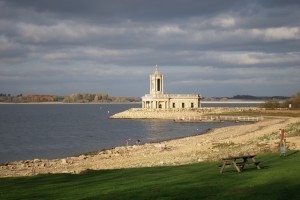 One consequence of drought was the spread of diseases such as typhoid and cholera. The “Great Stink” of London in 1858 was caused in no small part by the hot summer and the lack of rain. The Thames and many of its tributaries were overflowing with sewage and the warm weather encouraged bacteria to thrive causing both illness and terrible smells (smells so bad that there were plans for Parliament to move upriver to Hampton Court and for the law courts to relocate to Oxford.) The situation was eased when the weather broke with heavy rain, as it always seems to do.
One consequence of drought was the spread of diseases such as typhoid and cholera. The “Great Stink” of London in 1858 was caused in no small part by the hot summer and the lack of rain. The Thames and many of its tributaries were overflowing with sewage and the warm weather encouraged bacteria to thrive causing both illness and terrible smells (smells so bad that there were plans for Parliament to move upriver to Hampton Court and for the law courts to relocate to Oxford.) The situation was eased when the weather broke with heavy rain, as it always seems to do.
One of the rather curious things that occurs when there is a drought is that parch marks in the fields reveal the outlines of ancient building and field systems. Another is that those valleys flooded to make reservoirs such as Mardale in the Lake District and Ladybower in Derbyshire reveal the ruins of the villages lost when the area was “drowned.” Here is one such lost village commemorated in verse:
“King’s tower and Queen’s bower
And weed and reed in the gloom;
And a lost city in Semmerwater
Deep asleep till doom.”
From The Ballad of Semmerwater by Sir William Watson.
©2012 Nicola Cornick. All Rights Reserved.
.April 18, 2012
The Golden Age of Roman Britain
The Roman period in Britain is an intriguing time and one of my favourite eras to read about. The fact that there are still many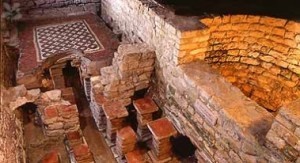 Roman sites to visit as well adds depth and colour to research into the period. Last week I visited Chedworth Roman Villa near Cirencester in Gloucestershire, one of the largest Romano-British villas in England.
Roman sites to visit as well adds depth and colour to research into the period. Last week I visited Chedworth Roman Villa near Cirencester in Gloucestershire, one of the largest Romano-British villas in England.
Chedworth was discovered in 1864 when a gamekeeper found some small tesserae, pieces of buried mosaic. It’s fascinating to me to think of a villa lying buried beneath the accumulated earth of almost two thousand years. When did it fall down, how was it lost, when did it’s presence and those of villas like it fade from awareness? Were bits of it still visible 500 years after the decline of Roman civilisation in the country or had it vanished even then?
The heyday of Chedworth’s villa was in the 4th century AD when it was a large and luxurious country house with underfloor heating and two bath houses. Several of the fine mosaics survive, giving a glimpse of the style and opulence of the villa. The existence of the villa also gives an insight into the peaceful times in which it flourished before the fall of Rome, the withdrawal of troops from Britain and the gradual decline of the Roman way of life. It’s a rich setting for a historical author and one which I hope to explore in my writing one day.
©2012 Nicola Cornick. All Rights Reserved.
.April 11, 2012
A visit to Downton Abbey!
Over on the Word Wenches blog today I am chatting about the visit I made last week to Highclere Castle, the fabulous Victorian mansion that is used in the filming of Downton Abbey. Please do drop in to the Wenches to read all about our visit and get some of the behind the scenes Downton gossip! The post is here: http://bit.ly/HGrRgx I'm also offering a copy of my Edwardian book Dauntsey Park to one commenter in honour of our visit!
Please do drop in to the Wenches to read all about our visit and get some of the behind the scenes Downton gossip! The post is here: http://bit.ly/HGrRgx I'm also offering a copy of my Edwardian book Dauntsey Park to one commenter in honour of our visit!
©2012 Nicola Cornick. All Rights Reserved.
.April 7, 2012
Three Hundred and Fifty Years of Conservation
Today at the UK Historical Authors' Blog I am talking about the conservation work at Ashdown House and the stunning hard hat 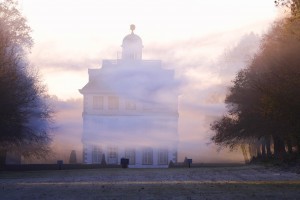 tours that are available to visitors this season. My fellow guides and I are now fully trained to take people up to the seventh floor of the scaffolding to view the ongoing restoration work on the house. It's fascinating stuff, from the dates carved into the stone by the original builders to the bright red colour scheme originally inside the house! If you are visiting Oxfordshire do come and visit us and see for yourself the wonderful historical artefacts and hear the story of Ashdown through 350 years of history!
tours that are available to visitors this season. My fellow guides and I are now fully trained to take people up to the seventh floor of the scaffolding to view the ongoing restoration work on the house. It's fascinating stuff, from the dates carved into the stone by the original builders to the bright red colour scheme originally inside the house! If you are visiting Oxfordshire do come and visit us and see for yourself the wonderful historical artefacts and hear the story of Ashdown through 350 years of history!
©2012 Nicola Cornick. All Rights Reserved.
.April 5, 2012
Prizewinners and another contest!
First of all a big thank you to those of you who entered the Notorious contest. The winner is Amy who wins a selection of books and some goodies from Highclere Castle, the home of Downton Abbey. Congratulations, Amy! I'll be blogging about Highclere/Downton next week. Don't miss it! Here is Rochester the Guide Dog Puppy with the castle in the background, looking every inch the aristocratic dog!
Downton Abbey. Congratulations, Amy! I'll be blogging about Highclere/Downton next week. Don't miss it! Here is Rochester the Guide Dog Puppy with the castle in the background, looking every inch the aristocratic dog!
Congratulations also to Rebecca, who won last month's website contest and a set of the Brides of Fortune books. There will be a new website contest coming very soon.
And as it's a holiday weekend and I'm still celebrating the release of Notorious, here is another fun contest. I recently did a quiz to find my "inner animal." You can take the quiz here. Apparently I am a red squirrel! So I wondered – what do you think your inner animal would be? I'm offering a copy of a backlist book of your choice plus some lovely luxury bath and body gifts as the prize. The draw will be made on Tuesday 10th April. Have a wonderful weekend!
©2012 Nicola Cornick. All Rights Reserved.
.April 2, 2012
Notorious Contest!
Happy April! As I sit at my desk looking out over the Oxfordshire countryside it's a beautiful day with the mist starting to vanish in the sun and the hills a patchwork of green and brown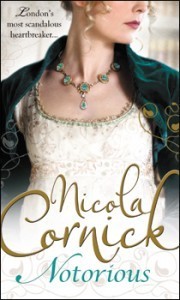 against the blue of the sky.
against the blue of the sky.
Notorious is published in the UK this month and to celebrate I am holding a little contest here on the blog. To enter, simply tell me what you would like to be notorious – or famous – for! The prize is a selection of books: The Wicked Wyckerly by NYT bestselling author Patricia Rice, To Sin with a Scoundrel by Cara Elliott and my own Dauntsey Park. Plus, I am visiting Highclere Castle, the set of Downton Abbey, this week, so I will be throwing in a few Downton goodies as well! I'll make the drawing on Thursday and post the result here on the blog. Be sure to check back and to make sure I have your contact details in case you win!
Thank you for visiting and I hope you have a very happy week!
©2012 Nicola Cornick. All Rights Reserved.
.March 30, 2012
Fossils!
Have you ever wondered what people in earlier centuries thought when they discovered the fossilised remains of dinosaurs? I've got to admit I hadn't thought about it – until I watched a fascinating programme on how people interpreted fossils in the days before Darwin's theory of evolution.
to admit I hadn't thought about it – until I watched a fascinating programme on how people interpreted fossils in the days before Darwin's theory of evolution.
Back in the Middle Ages, dinosaur footprints were blamed on the devil. Fossils from the quarry at Storeton in Cheshire were incorporated over the doorway of the nearby church at Higher Bebington in order to neutralise their evil powers. Dinosaur bones were also thought to be the skeletons of dragons. There were many myths of malign dragons, from the German dragon slain by Siegfried to the legend of Saint George. A huge dinosaur skull found in Austria in 1335 was said to be the skull of a dragon slain by a knight. This fitted the legend of the founding of the town of Klagenfurt, which had been built on swamps formerly inhabited by the dragon "Lindwurm." The town erected a statue of the dragon in 1590 and it was not until 1840 that the skull was identified as the head of a woolly rhinoceros.
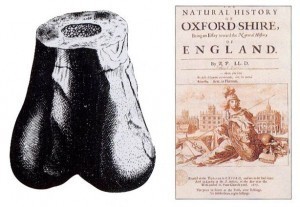 Oxford's Ashmolean Museum opened in 1683 and had a dinosaur bone as one of its main exhibits. In his book "The Natural History of Oxfordshire," Robert Plott, the First Keeper of the Museum, tried to work out what it was. He originally identified it as the bone of an elephant that had been brought to Britain by the Romans, but this theory foundered when a travelling menagerie came to Oxford and it included a live elephant. Plott measured the live elephant and saw it was significantly smaller than the bone. He also ruled out the possibility of it being from a horse or ox and concluded it was from a giant. The bone was again described in 1763 by Richard Brookes who called it "scrotum humanum" and compared its appearance to a pair of human testicles.
Oxford's Ashmolean Museum opened in 1683 and had a dinosaur bone as one of its main exhibits. In his book "The Natural History of Oxfordshire," Robert Plott, the First Keeper of the Museum, tried to work out what it was. He originally identified it as the bone of an elephant that had been brought to Britain by the Romans, but this theory foundered when a travelling menagerie came to Oxford and it included a live elephant. Plott measured the live elephant and saw it was significantly smaller than the bone. He also ruled out the possibility of it being from a horse or ox and concluded it was from a giant. The bone was again described in 1763 by Richard Brookes who called it "scrotum humanum" and compared its appearance to a pair of human testicles.
In 1788 a Scottish geologist claimed the earth was very ancient, a great deal older than scientists had previously imagined. In 1815 fossils of the bones and teeth of an enormous creature were uncovered at a slate mine in North Oxfordshire. These were found in a particular layer of rock and identified as very old. William Buckland, Oxford Professor of Geology, identified them as belonging to a very large carnivorous lizard forty foot long and eight foot high. This created a difficult challenge to the bible.
It was Richard Owen, an anatomist and the founder of the Natural History Museum who coined the name dinosaur or "terrible lizard." During the 1850s there was a craze for dinosuars and a Victorian dinosaur theme park was established at Crystal Palace which is still there. The "dinosaurs" were made of plaster and were extremely inaccurate in appearance but this is the oldest dinosaur theme park in the world.
lizard." During the 1850s there was a craze for dinosuars and a Victorian dinosaur theme park was established at Crystal Palace which is still there. The "dinosaurs" were made of plaster and were extremely inaccurate in appearance but this is the oldest dinosaur theme park in the world.
I do like the stories of the fossil hunters from the Regency period and very much enjoyed Deborah Cadbury's book The Dinousar Hunters about this early period in the identifying of the dinosaurs.
©2012 Nicola Cornick. All Rights Reserved.
.March 28, 2012
History changes everything!
Over on the Word Wenches Blog today I am talking about my neighbourhood and the changes it has seen over the past twenty years.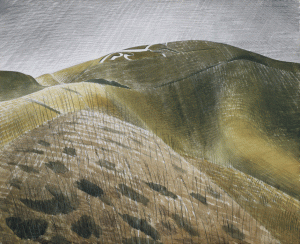 And the past two thousand years. Come and drop in to tell me what life is like where you live and how things have changed!
And the past two thousand years. Come and drop in to tell me what life is like where you live and how things have changed!
©2012 Nicola Cornick. All Rights Reserved.
.March 24, 2012
Hidden Gems – Lodge Park
As Spring arrives and many British stately homes open to the public for the season it's natural that lots of the big and famous houses such as Blenheim and Chatsworth attract a lot of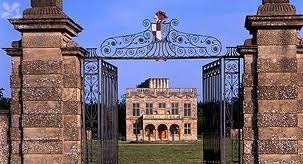 interest. They are spectacular, of course, and well worth visiting. But it's also nice to share and celebrate the smaller, quirkier places that don't get onto the tourist radar as easily. As someone who works in just such a place, Ashdown House in Oxfordshire, I know how hard the smaller properties work to attract visitors and make their trip as fascinating as any tour of a grand mansion. So here is my new occasional historical series in tribute to the hidden gems! Today I am starting with Lodge Park in Gloucestershire, a stunning little property where I worked for a year.
interest. They are spectacular, of course, and well worth visiting. But it's also nice to share and celebrate the smaller, quirkier places that don't get onto the tourist radar as easily. As someone who works in just such a place, Ashdown House in Oxfordshire, I know how hard the smaller properties work to attract visitors and make their trip as fascinating as any tour of a grand mansion. So here is my new occasional historical series in tribute to the hidden gems! Today I am starting with Lodge Park in Gloucestershire, a stunning little property where I worked for a year.
Strictly speaking, Lodge Park isn't a home, stately or otherwise. It's a grandstand, built in the 17th century by John "Crump" Dutton (who was a consummate English Civil War era politician) for deer coursing, gambling, entertaining and banqueting. The Dutton mansion was down the road in the village of Sherborne where there is still a fabulous pleasure garden to visit (more on that in a minute). A description of Lodge Park written in 1634 suggests that it was inspired by Inigo Jones' Banqueting House in Whitehall in London.
 One of the most interesting things about Lodge Park is that it was reconstructed using the original plans and archaeological evidence, and as much original material as possible. Stepping into the entrance hall with its Cotswold stone floor and moulded stone fireplace immediately transports you into the 17th century. The Great Room on the first floor stretches the length of the building and has another magnificent fireplace and double doors opening onto the balcony. As at Ashdown, visitors can also access the viewing platform on the roof where John Dutton's guests would assemble to watch the deer coursing.
One of the most interesting things about Lodge Park is that it was reconstructed using the original plans and archaeological evidence, and as much original material as possible. Stepping into the entrance hall with its Cotswold stone floor and moulded stone fireplace immediately transports you into the 17th century. The Great Room on the first floor stretches the length of the building and has another magnificent fireplace and double doors opening onto the balcony. As at Ashdown, visitors can also access the viewing platform on the roof where John Dutton's guests would assemble to watch the deer coursing.
One of the best things about Lodge Park? The fact that you can hire it for events, from wedding to book signings (and how I would love to do that!) They also host living history events; I met some lovely highwaymen there one year. Whilst you are there you can also stroll through Sherborne's 17th century water meadows and visit the pleasure gardens with their meandering paths, ice house and secluded shady benches. History bliss!
©2012 Nicola Cornick. All Rights Reserved.
.March 22, 2012
Interview and Giveaway with Elise Rome
Today I am the guest of fabulous author Elise Rome at her March Madness celebration. There is an interview and book giveaway, and we are chatting about the sort of disguise you would choose if, like Tess in Desired, you needed to make a swift exit without getting caught. Please come along (in your fancy dress of choice, of course) and join in the fun! We're at http://bit.ly/GF8VNf and I look forward to chatting with you!
would choose if, like Tess in Desired, you needed to make a swift exit without getting caught. Please come along (in your fancy dress of choice, of course) and join in the fun! We're at http://bit.ly/GF8VNf and I look forward to chatting with you!
©2012 Nicola Cornick. All Rights Reserved.
.


